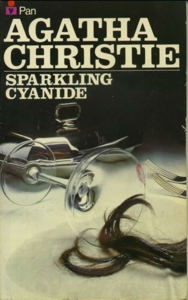You need to sign in or sign up before continuing.
Take a photo of a barcode or cover
mysterious
fast-paced
Plot or Character Driven:
A mix
Strong character development:
N/A
Loveable characters:
N/A
Diverse cast of characters:
N/A
Flaws of characters a main focus:
Yes
mysterious
medium-paced
Plot or Character Driven:
Plot
Strong character development:
No
Loveable characters:
Yes
Diverse cast of characters:
No
Flaws of characters a main focus:
Yes
mysterious
tense
fast-paced
Plot or Character Driven:
Plot
Strong character development:
Yes
Loveable characters:
No
Diverse cast of characters:
No
Flaws of characters a main focus:
Yes
Remembered Death (a.k.a., Sparkling Cyanide) offers a "Rashoman"-like opening with different characters remembering the deceased Rosemary Barton, who committed suicide very publicly at a gathering at a London nightclub. Each character sees her from different perspectives. But midway through the book, we shift to a more traditional present-tense telling of the lead-up to the anniversary of Rosemary's death.
Widowed George Barton has received anonymous letters suggesting Rosemary did not commit suicide, but was murdered. Now he is obsessed with exposing her killer. He suspects Rosemary's ;over, political rising star Stephen Farraday. Or is it mysterious Anthony Brown? Can George trust his loyal secretary, Ruth? And can he truly believe that Rosemary's sister Iris, who inherited her sister's wealth, did not know about Rosemary's secret lover?
When George's plot to trap the killer by recreating the event where Rosemary died goes awry, Scotland Yard must step in to try to resolve two murders... before any more occur.
Agatha Christie created so many of of the plot lines used in mysteries that her books can seem trite today. I've never found her characters much more than cartoons. They can seem insubstantial, and I seldom feel vested in their fates. Christie's strength has always been her convoluted plots and twist revelations of the murderers. This is a stand-alone volume without Christie's famed detectives Miss Marple or Hercule Poirot.
This edition is a Pocket Books paperback, 1973, with cover art by David FeBland, ISBN 0-671-54320-2.
Widowed George Barton has received anonymous letters suggesting Rosemary did not commit suicide, but was murdered. Now he is obsessed with exposing her killer. He suspects Rosemary's ;over, political rising star Stephen Farraday. Or is it mysterious Anthony Brown? Can George trust his loyal secretary, Ruth? And can he truly believe that Rosemary's sister Iris, who inherited her sister's wealth, did not know about Rosemary's secret lover?
When George's plot to trap the killer by recreating the event where Rosemary died goes awry, Scotland Yard must step in to try to resolve two murders... before any more occur.
Agatha Christie created so many of of the plot lines used in mysteries that her books can seem trite today. I've never found her characters much more than cartoons. They can seem insubstantial, and I seldom feel vested in their fates. Christie's strength has always been her convoluted plots and twist revelations of the murderers. This is a stand-alone volume without Christie's famed detectives Miss Marple or Hercule Poirot.
This edition is a Pocket Books paperback, 1973, with cover art by David FeBland, ISBN 0-671-54320-2.
I love a good Agatha Christie mystery. This one didn’t disappoint. I love how everyone is a suspect until all the pieces add up. This one was fun because you got to see everyone’s POV before the case got even more mysterious.
mysterious
fast-paced
mysterious
relaxing
fast-paced
Plot or Character Driven:
Plot
Strong character development:
Complicated
Loveable characters:
Yes
Diverse cast of characters:
Yes
Flaws of characters a main focus:
No
dark
mysterious
Parts of the book now quite outdated but the mystery itself really very good.





